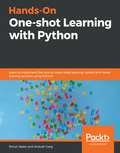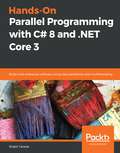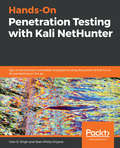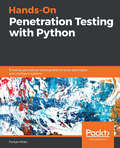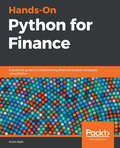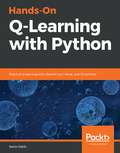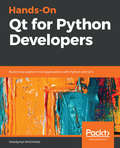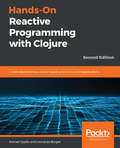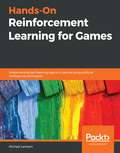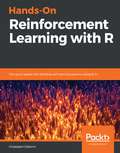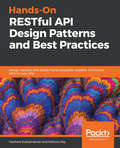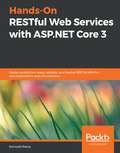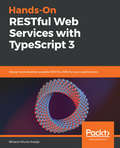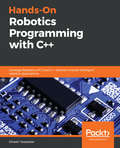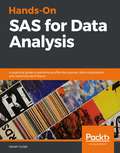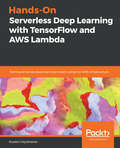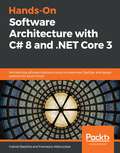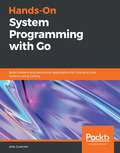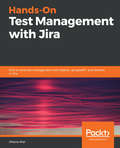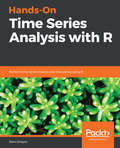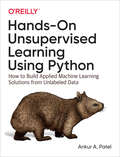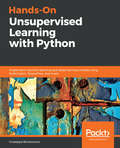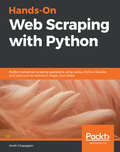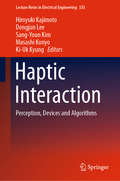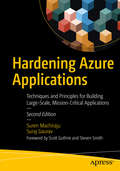- Table View
- List View
Hands-On One-shot Learning with Python: Learn to implement fast and accurate deep learning models with fewer training samples using PyTorch
by Shruti Jadon Ankush GargGet to grips with building powerful deep learning models using PyTorch and scikit-learn Key Features Learn how you can speed up the deep learning process with one-shot learning Use Python and PyTorch to build state-of-the-art one-shot learning models Explore architectures such as Siamese networks, memory-augmented neural networks, model-agnostic meta-learning, and discriminative k-shot learning Book Description One-shot learning has been an active field of research for scientists trying to develop a cognitive machine that mimics human learning. With this book, you'll explore key approaches to one-shot learning, such as metrics-based, model-based, and optimization-based techniques, all with the help of practical examples. Hands-On One-shot Learning with Python will guide you through the exploration and design of deep learning models that can obtain information about an object from one or just a few training samples. The book begins with an overview of deep learning and one-shot learning and then introduces you to the different methods you can use to achieve it, such as deep learning architectures and probabilistic models. Once you've got to grips with the core principles, you'll explore real-world examples and implementations of one-shot learning using PyTorch 1.x on datasets such as Omniglot and MiniImageNet. Finally, you'll explore generative modeling-based methods and discover the key considerations for building systems that exhibit human-level intelligence. By the end of this book, you'll be well-versed with the different one- and few-shot learning methods and be able to use them to build your own deep learning models. What you will learn Get to grips with the fundamental concepts of one- and few-shot learning Work with different deep learning architectures for one-shot learning Understand when to use one-shot and transfer learning, respectively Study the Bayesian network approach for one-shot learning Implement one-shot learning approaches based on metrics, models, and optimization in PyTorch Discover different optimization algorithms that help to improve accuracy even with smaller volumes of data Explore various one-shot learning architectures based on classification and regression Who this book is for If you're an AI researcher or a machine learning or deep learning expert looking to explore one-shot learning, this book is for you. It will help you get started with implementing various one-shot techniques to train models faster. Some Python programming experience is necessary to understand the concepts covered in this book.
Hands-On Parallel Programming with C# 8 and .NET Core 3: Build solid enterprise software using task parallelism and multithreading
by Shakti TanwarEnhance your enterprise application development skills by mastering parallel programming techniques in .NET and C# Key Features Write efficient, fine-grained, and scalable parallel code with C# and .NET Core Experience how parallel programming works by building a powerful application Learn the fundamentals of multithreading by working with IIS and Kestrel Book Description In today's world, every CPU has a multi-core processor. However, unless your application has implemented parallel programming, it will fail to utilize the hardware's full processing capacity. This book will show you how to write modern software on the optimized and high-performing .NET Core 3 framework using C# 8. Hands-On Parallel Programming with C# 8 and .NET Core 3 covers how to build multithreaded, concurrent, and optimized applications that harness the power of multi-core processors. Once you've understood the fundamentals of threading and concurrency, you'll gain insights into the data structure in .NET Core that supports parallelism. The book will then help you perform asynchronous programming in C# and diagnose and debug parallel code effectively. You'll also get to grips with the new Kestrel server and understand the difference between the IIS and Kestrel operating models. Finally, you'll learn best practices such as test-driven development, and run unit tests on your parallel code. By the end of the book, you'll have developed a deep understanding of the core concepts of concurrency and asynchrony to create responsive applications that are not CPU-intensive. What you will learn Analyze and break down a problem statement for parallelism Explore the APM and EAP patterns and how to move legacy code to Task Apply reduction techniques to get aggregated results Create PLINQ queries and study the factors that impact their performance Solve concurrency problems caused by producer-consumer race conditions Discover the synchronization primitives available in .NET Core Understand how the threading model works with IIS and Kestrel Find out how you can make the most of server resources Who this book is for If you want to learn how task parallelism is used to build robust and scalable enterprise architecture, this book is for you. Whether you are a beginner to parallelism in C# or an experienced architect, you'll find this book useful to gain insights into the different threading models supported in .NET Standard and .NET Core. Prior knowledge of C# is required to understand the concepts covered in this book.
Hands-On Penetration Testing with Kali NetHunter: Spy on and protect vulnerable ecosystems using the power of Kali Linux for pentesting on the go
by Sean-Philip Oriyano Glen D. SinghConvert Android to a powerful pentesting platform.Key FeaturesGet up and running with Kali Linux NetHunter Connect your Android device and gain full control over Windows, OSX, or Linux devices Crack Wi-Fi passwords and gain access to devices connected over the same network collecting intellectual dataBook DescriptionKali NetHunter is a version of the popular and powerful Kali Linux pentesting platform, designed to be installed on mobile devices. Hands-On Penetration Testing with Kali NetHunter will teach you the components of NetHunter and how to install the software. You’ll also learn about the different tools included and how to optimize and use a package, obtain desired results, perform tests, and make your environment more secure. Starting with an introduction to Kali NetHunter, you will delve into different phases of the pentesting process. This book will show you how to build your penetration testing environment and set up your lab. You will gain insight into gathering intellectual data, exploiting vulnerable areas, and gaining control over target systems. As you progress through the book, you will explore the NetHunter tools available for exploiting wired and wireless devices. You will work through new ways to deploy existing tools designed to reduce the chances of detection. In the concluding chapters, you will discover tips and best practices for integrating security hardening into your Android ecosystem. By the end of this book, you will have learned to successfully use a mobile penetration testing device based on Kali NetHunter and Android to accomplish the same tasks you would traditionally, but in a smaller and more mobile form factor.What you will learnChoose and configure a hardware device to use Kali NetHunter Use various tools during pentests Understand NetHunter suite components Discover tips to effectively use a compact mobile platform Create your own Kali NetHunter-enabled device and configure it for optimal results Learn to scan and gather information from a target Explore hardware adapters for testing and auditing wireless networks and Bluetooth devicesWho this book is forHands-On Penetration Testing with Kali NetHunter is for pentesters, ethical hackers, and security professionals who want to learn to use Kali NetHunter for complete mobile penetration testing and are interested in venturing into the mobile domain. Some prior understanding of networking assessment and Kali Linux will be helpful.
Hands-On Penetration Testing with Python: Enhance your ethical hacking skills to build automated and intelligent systems
by Furqan KhanHands-On Penetration Testing with Python is for you if you are a developer with prior knowledge of Python, and want in-depth insight into the pentesting ecosystem. This book guides you through the advanced use of Python for cybersecurity and pentesting, helping you to better understand security loopholes within your infrastructure and cloud environments.
Hands-On Python for Finance: A practical guide to implementing financial analysis strategies using Python
by Krish NaikLearn and implement quantitative finance using popular Python libraries like NumPy, pandas, and Keras Key Features Understand Python data structure fundamentals and work with time series data Use popular Python libraries including TensorFlow, Keras, and SciPy to deploy key concepts in quantitative finance Explore various Python programs and learn finance paradigms Book Description Python is one of the most popular languages used for quantitative finance. With this book, you'll explore the key characteristics of Python for finance, solve problems in finance, and understand risk management. The book starts with major concepts and techniques related to quantitative finance, and an introduction to some key Python libraries. Next, you'll implement time series analysis using pandas and DataFrames. The following chapters will help you gain an understanding of how to measure the diversifiable and non-diversifiable security risk of a portfolio and optimize your portfolio by implementing Markowitz Portfolio Optimization. Sections on regression analysis methodology will help you to value assets and understand the relationship between commodity prices and business stocks. In addition to this, you'll be able to forecast stock prices using Monte Carlo simulation. The book will also highlight forecast models that will show you how to determine the price of a call option by analyzing price variation. You'll also use deep learning for financial data analysis and forecasting. In the concluding chapters, you will create neural networks with TensorFlow and Keras for forecasting and prediction. By the end of this book, you will be equipped with the skills you need to perform different financial analysis tasks using Python What you will learn Clean financial data with data preprocessing Visualize financial data using histograms, color plots, and graphs Perform time series analysis with pandas for forecasting Estimate covariance and the correlation between securities and stocks Optimize your portfolio to understand risks when there is a possibility of higher returns Calculate expected returns of a stock to measure the performance of a portfolio manager Create a prediction model using recurrent neural networks (RNN) with Keras and TensorFlow Who this book is for This book is ideal for aspiring data scientists, Python developers and anyone who wants to start performing quantitative finance using Python. You can also make this beginner-level guide your first choice if you're looking to pursue a career as a financial analyst or a data analyst. Working knowledge of Python programming language is necessary.
Hands-On Q-Learning with Python: Practical Q-learning with OpenAI Gym, Keras, and TensorFlow
by Nazia HabibLeverage the power of reward-based training for your deep learning models with Python Key Features Understand Q-learning algorithms to train neural networks using Markov Decision Process (MDP) Study practical deep reinforcement learning using Q-Networks Explore state-based unsupervised learning for machine learning models Book Description Q-learning is a machine learning algorithm used to solve optimization problems in artificial intelligence (AI). It is one of the most popular fields of study among AI researchers. This book starts off by introducing you to reinforcement learning and Q-learning, in addition to helping you get familiar with OpenAI Gym as well as libraries such as Keras and TensorFlow. A few chapters into the book, you will gain insights into modelfree Q-learning and use deep Q-networks and double deep Q-networks to solve complex problems. This book will guide you in exploring use cases such as self-driving vehicles and OpenAI Gym's CartPole problem. You will also learn how to tune and optimize Q-networks and their hyperparameters. As you progress, you will understand the reinforcement learning approach to solving real-world problems. You will also explore how to use Q-learning and related algorithms in real-world applications such as scientific research. Toward the end, you'll gain a sense of what's in store for reinforcement learning. By the end of this book, you will be equipped with the skills you need to solve reinforcement learning problems using Q-learning algorithms with OpenAI Gym, Keras, and TensorFlow. What you will learn Explore the fundamentals of reinforcement learning and the state-action-reward process Understand Markov decision processes Get well versed with libraries such as Keras, and TensorFlow Create and deploy model-free learning and deep Q-learning agents with TensorFlow, Keras, and OpenAI Gym Choose and optimize a Q-Network's learning parameters and fine-tune its performance Discover real-world applications and use cases of Q-learning Who this book is for If you are a machine learning developer, engineer, or professional who wants to delve into the deep learning approach for a complex environment, then this is the book for you. Proficiency in Python programming and basic understanding of decision-making in reinforcement learning is assumed.
Hands-On Qt for Python Developers: Build cross-platform GUI applications with Python and Qt 5
by Volodymyr KirichinetsBoost UI development with ready-made widgets, controls, charts, and data visualization and create stunning 2D and 3D graphics with PyQt and PySide2.Key FeaturesBuild optimized GUI applications by implementing multiprocessing and concurrencyUnderstand embedded and mobile development with PyQt and PySideLearn to create magnificent GUI applications using Pyside2 and QtQuick/QMLBook DescriptionQt is one of the most widely used and flexible frameworks for GUI application development, allowing you to write your application once and then deploy it to multiple operating systems. This book combines the best of Python and Qt to help you develop GUI applications with Python bindings, such as PyQt and PySide, that will supercharge your Python applications.The book begins with an overview of Qt and QML. You’ll start by working with PyQt GUI elements to style your applications. Then, you will learn how to use QWidget, frames, labels, and text fields, and work with graphics. This will be followed by taking you through how elements in the application communicate with each other by understanding signals, slots, and event handlers. This book will help you to gain a better understanding of the Qt framework and the tools to resolve issues when testing, linking, debugging, and multithreading your Python GUI applications. Finally, the book will help you get to grips with embedded and mobile development using PyQt and PySide.By the end of the book, you will be able to create modern, responsive, cross-platform desktop applications with the power of Qt, Python, and QML.What you will learnExplore PyQt5 and PySide2 to create comprehensive GUI applicationsFind out how threading and multiprocessing workUnderstand how to style GUIs with PyQtGet to grips with implementing buttonsUnderstand how elements communicate with signals, slots, and event handlersExplore mobile development with PyQt and PySideWho this book is forThis book is for Python developers who want to develop GUIs and cross-platform applications that are modern, responsive, and attractive. No prior knowledge of Qt or QML is required.
Hands-On Reactive Programming with Clojure: Create asynchronous, event-based, and concurrent applications, 2nd Edition
by Leonardo Borges Konrad SzydloLearn how to use RxClojure to deal with stateful computations Key Features Leverage the features of Functional Reactive Programming using Clojure Create dataflow-based systems that are the building blocks of Reactive Programming Use different Functional Reactive Programming frameworks, techniques, and patterns to solve real-world problems Book Description Reactive Programming is central to many concurrent systems, and can help make the process of developing highly concurrent, event-driven, and asynchronous applications simpler and less error-prone. This book will allow you to explore Reactive Programming in Clojure 1.9 and help you get to grips with some of its new features such as transducers, reader conditionals, additional string functions, direct linking, and socket servers. Hands-On Reactive Programming with Clojure starts by introducing you to Functional Reactive Programming (FRP) and its formulations, as well as showing you how it inspired Compositional Event Systems (CES). It then guides you in understanding Reactive Programming as well as learning how to develop your ability to work with time-varying values thanks to examples of reactive applications implemented in different frameworks. You'll also gain insight into some interesting Reactive design patterns such as the simple component, circuit breaker, request-response, and multiple-master replication. Finally, the book introduces microservices-based architecture in Clojure and closes with examples of unit testing frameworks. By the end of the book, you will have gained all the knowledge you need to create applications using different Reactive Programming approaches. What you will learn Understand how to think in terms of time-varying values and event streams Create, compose, and transform observable sequences using Reactive extensions Build a CES framework from scratch using core.async as its foundation Develop a simple ClojureScript game using Reagi Integrate Om and RxJS in a web application Implement a reactive API in Amazon Web Services (AWS) Discover helpful approaches to backpressure and error handling Get to grips with futures and their applications Who this book is for If you're interested in using Reactive Programming to build asynchronous and concurrent applications, this is the book for you. Basic knowledge of Clojure programming is necessary to understand the concepts covered in this book.
Hands-On Reinforcement Learning for Games: Implementing self-learning agents in games using artificial intelligence techniques
by Micheal LanhamExplore reinforcement learning (RL) techniques to build cutting-edge games using Python libraries such as PyTorch, OpenAI Gym, and TensorFlow Key Features Get to grips with the different reinforcement and DRL algorithms for game development Learn how to implement components such as artificial agents, map and level generation, and audio generation Gain insights into cutting-edge RL research and understand how it is similar to artificial general research Book Description With the increased presence of AI in the gaming industry, developers are challenged to create highly responsive and adaptive games by integrating artificial intelligence into their projects. This book is your guide to learning how various reinforcement learning techniques and algorithms play an important role in game development with Python. Starting with the basics, this book will help you build a strong foundation in reinforcement learning for game development. Each chapter will assist you in implementing different reinforcement learning techniques, such as Markov decision processes (MDPs), Q-learning, actor-critic methods, SARSA, and deterministic policy gradient algorithms, to build logical self-learning agents. Learning these techniques will enhance your game development skills and add a variety of features to improve your game agent's productivity. As you advance, you'll understand how deep reinforcement learning (DRL) techniques can be used to devise strategies to help agents learn from their actions and build engaging games. By the end of this book, you'll be ready to apply reinforcement learning techniques to build a variety of projects and contribute to open source applications. What you will learn Understand how deep learning can be integrated into an RL agent Explore basic to advanced algorithms commonly used in game development Build agents that can learn and solve problems in all types of environments Train a Deep Q-Network (DQN) agent to solve the CartPole balancing problem Develop game AI agents by understanding the mechanism behind complex AI Integrate all the concepts learned into new projects or gaming agents Who this book is for If you're a game developer looking to implement AI techniques to build next-generation games from scratch, this book is for you. Machine learning and deep learning practitioners, and RL researchers who want to understand how to use self-learning agents in the game domain will also find this book useful. Knowledge of game development and Python programming experience are required.
Hands-On Reinforcement Learning with R: Get up to speed with building self-learning systems using R 3.x
by Giuseppe CiaburroImplement key reinforcement learning algorithms and techniques using different R packages such as the Markov chain, MDP toolbox, contextual, and OpenAI Gym Key Features Explore the design principles of reinforcement learning and deep reinforcement learning models Use dynamic programming to solve design issues related to building a self-learning system Learn how to systematically implement reinforcement learning algorithms Book Description Reinforcement learning (RL) is an integral part of machine learning (ML), and is used to train algorithms. With this book, you'll learn how to implement reinforcement learning with R, exploring practical examples such as using tabular Q-learning to control robots. You'll begin by learning the basic RL concepts, covering the agent-environment interface, Markov Decision Processes (MDPs), and policy gradient methods. You'll then use R's libraries to develop a model based on Markov chains. You will also learn how to solve a multi-armed bandit problem using various R packages. By applying dynamic programming and Monte Carlo methods, you will also find the best policy to make predictions. As you progress, you'll use Temporal Difference (TD) learning for vehicle routing problem applications. Gradually, you'll apply the concepts you've learned to real-world problems, including fraud detection in finance, and TD learning for planning activities in the healthcare sector. You'll explore deep reinforcement learning using Keras, which uses the power of neural networks to increase RL's potential. Finally, you'll discover the scope of RL and explore the challenges in building and deploying machine learning models. By the end of this book, you'll be well-versed with RL and have the skills you need to efficiently implement it with R. What you will learn Understand how to use MDP to manage complex scenarios Solve classic reinforcement learning problems such as the multi-armed bandit model Use dynamic programming for optimal policy searching Adopt Monte Carlo methods for prediction Apply TD learning to search for the best path Use tabular Q-learning to control robots Handle environments using the OpenAI library to simulate real-world applications Develop deep Q-learning algorithms to improve model performance Who this book is for This book is for anyone who wants to learn about reinforcement learning with R from scratch. A solid understanding of R and basic knowledge of machine learning are necessary to grasp the topics covered in the book.
Hands-On RESTful API Design Patterns and Best Practices: Design, develop, and deploy highly adaptable, scalable, and secure RESTful web APIs
by Pethuru Raj Harihara SubramanianBuild effective RESTful APIs for enterprise with design patterns and REST framework's out-of-the-box capabilities Key Features Understand advanced topics such as API gateways, API securities, and cloud Implement patterns programmatically with easy-to-follow examples Modernize legacy codebase using API connectors, layers, and microservices Book Description This book deals with the Representational State Transfer (REST) paradigm, which is an architectural style that allows networked devices to communicate with each other over the internet. With the help of this book, you'll explore the concepts of service-oriented architecture (SOA), event-driven architecture (EDA), and resource-oriented architecture (ROA). This book covers why there is an insistence for high-quality APIs toward enterprise integration. It also covers how to optimize and explore endpoints for microservices with API gateways and touches upon integrated platforms and Hubs for RESTful APIs. You'll also understand how application delivery and deployments can be simplified and streamlined in the REST world. The book will help you dig deeper into the distinct contributions of RESTful services for IoT analytics and applications. Besides detailing the API design and development aspects, this book will assist you in designing and developing production-ready, testable, sustainable, and enterprise-grade APIs. By the end of the book, you'll be empowered with all that you need to create highly flexible APIs for next-generation RESTful services and applications. What you will learn Explore RESTful concepts, including URI, HATEOAS, and Code on Demand Study core patterns like Statelessness, Pagination, and Discoverability Optimize endpoints for linked microservices with API gateways Delve into API authentication, authorization, and API security implementations Work with Service Orchestration to craft composite and process-aware services Expose RESTful protocol-based APIs for cloud computing Who this book is for This book is primarily for web, mobile, and cloud services developers, architects, and consultants who want to build well-designed APIs for creating and sustaining enterprise-class applications. You'll also benefit from this book if you want to understand the finer details of RESTful APIs and their design techniques along with some tricks and tips.
Hands-On RESTful Web Services with ASP.NET Core 3: Design production-ready, testable, and flexible RESTful APIs for web applications and microservices
by Samuele RescaGet up to speed with the latest features of C# 8, ASP.NET Core 3 and .NET Core 3.1 LTS to create robust and maintainable web services Key Features Apply design patterns and techniques to achieve a reactive, scalable web service Document your web services using the OpenAPI standard and test them using Postman Explore mechanisms to implement a secure web service using client-side SSL and token authentication Book Description In recent times, web services have evolved to play a prominent role in web development. Applications are now designed to be compatible with any device and platform, and web services help us keep their logic and UI separate. Given its simplicity and effectiveness in creating web services, the RESTful approach has gained popularity, and this book will help you build RESTful web services using ASP.NET Core. This REST book begins by introducing you to the basics of the REST philosophy, where you'll study the different stages of designing and implementing enterprise-grade RESTful web services. You'll also gain a thorough understanding of ASP.NET Core's middleware approach and learn how to customize it. The book will later guide you through improving API resilience, securing your service, and applying different design patterns and techniques to achieve a scalable web service. In addition to this, you'll learn advanced techniques for caching, monitoring, and logging, along with implementing unit and integration testing strategies. In later chapters, you will deploy your REST web services on Azure and document APIs using Swagger and external tools such as Postman. By the end of this book, you will have learned how to design RESTful web services confidently using ASP.NET Core with a focus on code testability and maintainability. What you will learn Gain a comprehensive working knowledge of ASP.NET Core Integrate third-party tools and frameworks to build maintainable and efficient services Implement patterns using dependency injection to reduce boilerplate code and improve flexibility Use ASP.NET Core's out-of-the-box tools to test your applications Use Docker to run your ASP.NET Core web service in an isolated and self-contained environment Secure your information using HTTPS and token-based authentication Integrate multiple web services using resiliency patterns and messaging techniques Who this book is for This book is for anyone who wants to learn how to build RESTful web services with the ASP.NET Core framework to improve the scalability and performance of their applications. Basic knowledge of C# and .NET Core will help you make the best use of the code samples included in the book.
Hands-On RESTful Web Services with TypeScript 3: Design and develop scalable RESTful APIs for your applications
by Biharck AraújoThe book is aimed at web developers who have a basic understanding of the REST concepts and want to familiarize themselves with the idea of designing and developing RESTful APIs.
Hands-On Robotics Programming with C++: Leverage Raspberry Pi 3 and C++ libraries to build intelligent robotics applications
by Dinesh TavasalkarThis book is for developers, programmers and robotic enthusiasts interested in leveraging C++ to build exciting robotics applications. Some prior knowledge of C++ is necessary.
Hands-On SAS for Data Analysis: A practical guide to performing effective queries, data visualization, and reporting techniques
by Harish GulatiLeverage the full potential of SAS to get unique, actionable insights from your data Key Features Build enterprise-class data solutions using SAS and become well-versed in SAS programming Work with different data structures, and run SQL queries to manipulate your data Explore essential concepts and techniques with practical examples to confidently pass the SAS certification exam Book Description SAS is one of the leading enterprise tools in the world today when it comes to data management and analysis. It enables the fast and easy processing of data and helps you gain valuable business insights for effective decision-making. This book will serve as a comprehensive guide that will prepare you for the SAS certification exam. After a quick overview of the SAS architecture and components, the book will take you through the different approaches to importing and reading data from different sources using SAS. You will then cover SAS Base and 4GL, understanding data management and analysis, along with exploring SAS functions for data manipulation and transformation. Next, you'll discover SQL procedures and get up to speed on creating and validating queries. In the concluding chapters, you'll learn all about data visualization, right from creating bar charts and sample geographic maps through to assigning patterns and formats. In addition to this, the book will focus on macro programming and its advanced aspects. By the end of this book, you will be well versed in SAS programming and have the skills you need to easily handle and manage your data-related problems in SAS. What you will learn Explore a variety of SAS modules and packages for efficient data analysis Use SAS 4GL functions to manipulate, merge, sort, and transform data Gain useful insights into advanced PROC SQL options in SAS to interact with data Get to grips with SAS Macro and define your own macros to share data Discover the different graphical libraries to shape and visualize data with Apply the SAS Output Delivery System to prepare detailed reports Who this book is for Budding or experienced data professionals who want to get started with SAS will benefit from this book. Those looking to prepare for the SAS certification exam will also find this book to be a useful resource. Some understanding of basic data management concepts will help you get the most out of this book.
Hands-On Serverless Deep Learning with TensorFlow and AWS Lambda: Training serverless deep learning models using the AWS infrastructure
by Rustem FeyzkhanovUse the serverless computing approach to save time and money Key Features Save your time by deploying deep learning models with ease using the AWS serverless infrastructure Get a solid grip on AWS services and use them with TensorFlow for efficient deep learning Includes tips, tricks and best practices on serverless deep learning that you can use in a production environment Book Description One of the main problems with deep learning models is finding the right way to deploy them within the company's IT infrastructure. Serverless architecture changes the rules of the game—instead of thinking about cluster management, scalability, and query processing, it allows us to focus specifically on training the model. This book prepares you to use your own custom-trained models with AWS Lambda to achieve a simplified serverless computing approach without spending much time and money. You will use AWS Services to deploy TensorFlow models without spending hours training and deploying them. You'll learn to deploy with serverless infrastructures, create APIs, process pipelines, and more with the tips included in this book. By the end of the book, you will have implemented your own project that demonstrates how to use AWS Lambda effectively so as to serve your TensorFlow models in the best possible way. What you will learn Gain practical experience by working hands-on with serverless infrastructures (AWS Lambda) Export and deploy deep learning models using Tensorflow Build a solid base in AWS and its various functions Create a deep learning API using AWS Lambda Look at the AWS API gateway Create deep learning processing pipelines using AWS functions Create deep learning production pipelines using AWS Lambda and AWS Step Function Who this book is for This book will benefit data scientists who want to learn how to deploy models easily and beginners who want to learn about deploying into the cloud. No prior knowledge of TensorFlow or AWS is required.
Hands-On Software Architecture with C# 8 and .NET Core 3: Architecting software solutions using microservices, DevOps, and design patterns for Azure Cloud
by Francesco Abbruzzese Gabriel BaptistaDesign scalable and high-performance enterprise applications using the latest features of C# 8 and .NET Core 3 Key Features Become a software architect capable of creating modular apps for specific business needs Design high-performance software systems using the latest features of C# 8 and .NET Core 3 Solve scalability problems in web apps using enterprise architectural patterns Book Description Software architecture is the practice of implementing structures and systems that streamline the software development process and improve the quality of an app. With this software architecture book, you'll follow a hands-on approach to learning various architectural methods that will help you develop and deliver high-quality products. You'll begin by understanding how to transform user requirements into architectural needs and exploring the differences between functional and non-functional requirements. Next, you'll explore how to carefully choose a cloud solution for your infrastructure, along with covering dos and don'ts that will help you manage your app in a cloud-based environment. Later chapters will cover techniques and processes such as DevOps, microservices, and continuous integration, along with providing insights into implementing them using Microsoft technologies such as ASP.NET Core, the Entity Framework, Cosmos DB, and Azure DevOps. You will also learn about testing frameworks and automation tools that will help you through the development process. Finally, you'll discover design patterns and various software approaches that will allow you to solve common problems faced during development. By the end of this book, you'll be able to develop and deliver highly scalable enterprise-ready apps that meet customers' business needs. What you will learn Overcome real-world architectural challenges and solve design consideration issues Apply architectural approaches like Layered Architecture, service-oriented architecture (SOA), and microservices Learn to use tools like containers, Docker, and Kubernetes to manage microservices Get up to speed with Azure Cosmos DB for delivering multi-continental solutions Learn how to program and maintain Azure Functions using C# Understand when to use test-driven development (TDD) as an approach for software development Write automated functional test cases for your projects Who this book is for This book is for engineers and senior developers aspiring to become architects or looking to build enterprise applications with the .NET Stack. Experience with C# and .NET is required to understand this book.
Hands-On Systems Programming with Go: Build modern and concurrent applications for Unix and Linux systems using Golang
by Alex GuerrieriIf you are a developer who has intermediate knowledge of Go but little to no knowledge of UNIX and Linux system programming and want to learn and master system programming with Go, this book is for you.
Hands-On Test Management with JIRA: End-to-end Test Management With Zephyr, Synapsert, And Jenkins In Jira
by Afsana AtarThis book is for any quality assurance professional, software project manager or test manager interested in learning to implement test management best practices in their team or organization.
Hands-On Time Series Analysis with R: Perform time series analysis and forecasting using R
by Rami KrispinBuild efficient forecasting models using traditional time series models and machine learning algorithms.Key FeaturesPerform time series analysis and forecasting using R packages such as Forecast and h2oDevelop models and find patterns to create visualizations using the TSstudio and plotly packagesMaster statistics and implement time-series methods using examples mentionedBook DescriptionTime series analysis is the art of extracting meaningful insights from, and revealing patterns in, time series data using statistical and data visualization approaches. These insights and patterns can then be utilized to explore past events and forecast future values in the series.This book explores the basics of time series analysis with R and lays the foundations you need to build forecasting models. You will learn how to preprocess raw time series data and clean and manipulate data with packages such as stats, lubridate, xts, and zoo. You will analyze data and extract meaningful information from it using both descriptive statistics and rich data visualization tools in R such as the TSstudio, plotly, and ggplot2 packages. The later section of the book delves into traditional forecasting models such as time series linear regression, exponential smoothing (Holt, Holt-Winter, and more) and Auto-Regressive Integrated Moving Average (ARIMA) models with the stats and forecast packages. You'll also cover advanced time series regression models with machine learning algorithms such as Random Forest and Gradient Boosting Machine using the h2o package.By the end of this book, you will have the skills needed to explore your data, identify patterns, and build a forecasting model using various traditional and machine learning methods.What you will learnVisualize time series data and derive better insightsExplore auto-correlation and master statistical techniquesUse time series analysis tools from the stats, TSstudio, and forecast packagesExplore and identify seasonal and correlation patternsWork with different time series formats in RExplore time series models such as ARIMA, Holt-Winters, and moreEvaluate high-performance forecasting solutionsWho this book is forHands-On Time Series Analysis with R is ideal for data analysts, data scientists, and all R developers who are looking to perform time series analysis to predict outcomes effectively. A basic knowledge of statistics is required; some knowledge in R is expected, but not mandatory.
Hands-On Unsupervised Learning Using Python: How to Build Applied Machine Learning Solutions from Unlabeled Data
by Ankur A. PatelMany industry experts consider unsupervised learning the next frontier in artificial intelligence, one that may hold the key to general artificial intelligence. Since the majority of the world's data is unlabeled, conventional supervised learning cannot be applied. Unsupervised learning, on the other hand, can be applied to unlabeled datasets to discover meaningful patterns buried deep in the data, patterns that may be near impossible for humans to uncover.Author Ankur Patel shows you how to apply unsupervised learning using two simple production-ready Python frameworks: scikit-learn and TensorFlow using Keras. With code and hands-on examples, data scientists will identify difficult-to-find patterns in data and gain deeper business insight, detect anomalies, perform automatic feature engineering and selection, and generate synthetic datasets. All you need is programming and some machine learning experience to get started.Compare the strengths and weaknesses of the different machine learning approaches: supervised, unsupervised, and reinforcement learningSet up and manage machine learning projects end-to-endBuild an anomaly detection system to catch credit card fraudClusters users into distinct and homogeneous groupsPerform semisupervised learningDevelop movie recommender systems using restricted Boltzmann machinesGenerate synthetic images using generative adversarial networks
Hands-On Unsupervised Learning with Python: Implement Machine Learning And Deep Learning Models Using Scikit-learn, Tensorflow, And More
by Giuseppe BonaccorsoThis book is intended for statisticians, data scientists, machine learning developers, and deep learning practitioners who want to build smart applications by implementing key building block - unsupervised learning. Get well versed with all the new techniques and algorithms offered in machine learning and deep learning using real-world examples. Having some knowledge of machine learning concepts, and statistics will definitely help.
Hands-On Web Scraping with Python: Perform advanced scraping operations using various Python libraries and tools such as Selenium, Regex, and others
by Anish ChapagainCollect and scrape different complexities of data from the modern Web using the latest tools, best practices, and techniques Key Features Learn various scraping techniques using a range of Python libraries such as Scrapy and Beautiful Soup Build scrapers and crawlers to extract relevant information from the web Automate web scraping operations to bridge the accuracy gap and ease complex business needs Book Description Web scraping is an essential technique used in many organizations to scrape valuable data from web pages. This book will enable you to delve deeply into web scraping techniques and methodologies. This book will introduce you to the fundamental concepts of web scraping techniques and how they can be applied to multiple sets of web pages. We'll use powerful libraries from the Python ecosystem—such as Scrapy, lxml, pyquery, bs4, and others—to carry out web scraping operations. We will take an in-depth look at essential tasks to carry out simple to intermediate scraping operations such as identifying information from web pages, using patterns or attributes to retrieve information, and others. This book adopts a practical approach to web scraping concepts and tools, guiding you through a series of use cases and showing you how to use the best tools and techniques to efficiently scrape web pages. This book also covers the use of other popular web scraping tools, such as Selenium, Regex, and web-based APIs. By the end of this book, you will have learned how to efficiently scrape the web using different techniques with Python and other popular tools. What you will learn Analyze data and Information from web pages Learn how to use browser-based developer tools from the scraping perspective Use XPath and CSS selectors to identify and explore markup elements Learn to handle and manage cookies Explore advanced concepts in handling HTML forms and processing logins Optimize web securities, data storage, and API use to scrape data Use Regex with Python to extract data Deal with complex web entities by using Selenium to find and extract data Who this book is for This book is for Python programmers, data analysts, web scraping newbies, and anyone who wants to learn how to perform web scraping from scratch. If you want to begin your journey in applying web scraping techniques to a range of web pages, then this book is what you need! A working knowledge of the Python programming language is expected.
Haptic Interaction: Perception, Devices and Algorithms (Lecture Notes in Electrical Engineering #535)
by Hiroyuki Kajimoto Ki-Uk Kyung Masashi Konyo Dongjun Lee Sang-Youn KimThis book constitutes the proceedings of the third international conference AsiaHaptics 2018, held in Songdo, Korea. It presents the state-of-the-art of the diverse haptics (touch)-related research, including perception and illusion, development of haptics devices, and applications to a wide variety of fields such as education, medicine, telecommunication, navigation and entertainment. This book is a valuable resource not only for active haptics researchers, but also for general readers wishing to understand the status quo in this interdisciplinary area of science and technology.
Hardening Azure Applications: Techniques and Principles for Building Large-Scale, Mission-Critical Applications
by Suren Machiraju Suraj GauravBuild large-scale, mission-critical hardened applications on the Azure cloud platform. This 2nd edition provides information on the newer features in Azure, such as Linux extensions and supporting Azure Services such as HDInsight and SQL Server on Linux. Updated with new applications Hardening Azure Applications also discusses Scale Sets (VMSS), a major upgrade that enables autoscaling and seamlessly makes machines ready for high availability. The authors take you step by step through the process of evaluating and building applications with the appropriate hardness attributes. After a small introduction to cloud computing, you will learn about various cloud and hardened cloud applications in detail. Next, you will discover service fundamentals such as instrumentation, telemetry, and monitoring followed by key application experiences. Further, you will cover availability and the economics of 9s. Towards the end, you will see how to secure your application and learn about the modernization of software organisations, a new topic in this edition.After reading this book, you will master the techniques and engineering principles that every architect and developer needs to know to harden their Azure/.NET applications to ensure maximum reliability and high availability when deployed at scale.What You Will LearnUse techniques and principles to harden Azure/.NET applicationsSecure your applications on AzureCreate a scale set on Azure Work with service fundamentals such as instrumentation, telemetry, and monitoringWho This Book Is ForDevelopers and IT professionals who are working on Azure applications.
